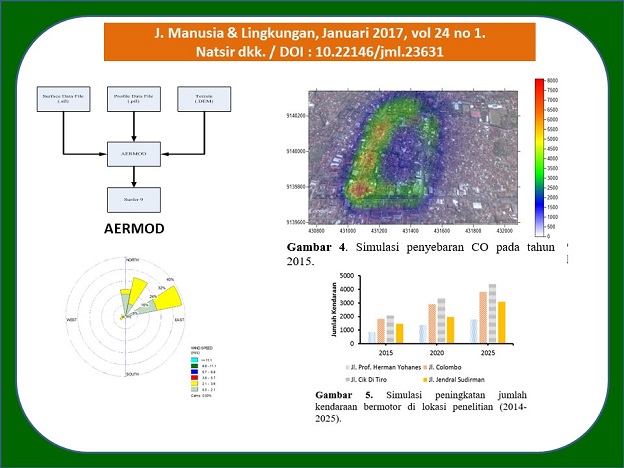
PENGGUNAAN AERMOD UNTUK KAJIAN SIMULASI DAMPAK PENCEMARAN KARBON MONOKSIDA DI KOTA YOGYAKARTA AKIBAT EMISI KENDARAAN BERMOTOR (Using Aermod to Simulation Study of Carbon Monoxide Pollution Effect in Yogyakarta City Caused by The Emission of Motor Vehicles)
Taufik Abdillah Natsir(1*), Yudith Windrianto Pambarep(2), Retno Susetyaningsih(3), Kris Setyanto(4), Rita Dewi(5)
(1) Departemen Kimia, Fakultas Matematika dan Ilmu Pengetahuan Alam, Universitas Gadjah Mada (UGM), Sekip utara Bulaksumur, Yogyakarta, 55281
(2) Teknik Lingkungan, Fakultas Teknik, Institut Teknologi Yogyakarta (ITY), Jl. Janti Km 4 Gedongkuning, Yogyakarta
(3) Teknik Lingkungan, Fakultas Teknik, Institut Teknologi Yogyakarta (ITY), Jl. Janti Km 4 Gedongkuning, Yogyakarta
(4) Teknik Lingkungan, Fakultas Teknik, Institut Teknologi Yogyakarta (ITY), Jl. Janti Km 4 Gedongkuning, Yogyakarta
(5) Teknik Lingkungan, Fakultas Teknik, Institut Teknologi Yogyakarta (ITY), Jl. Janti Km 4 Gedongkuning, Yogyakarta
(*) Corresponding Author
Abstract
Telah dilakukan penelitian terkait simulasi dampak pencemaran udara di Kota Yogyakarta akibat dari emisi kendaraan bermotor dengan menggunakan perangkat lunak AERMOD dan visualisasi hasil dengan menggunakan perangkat lunak SURFER 9. AERMOD merupakan perangkat lunak yang dikembangkan oleh US-EPA dan merupakan perangkat lunak yang direkomendasikan oleh US-EPA untuk memprakirakan dampak polutan udara. Penelitian dilakukan di 4 ruas jalan kota Yogyakarta, yaitu jalan Cik Di Tiro, jalan Prof. Herman Yohanes, jalan Colombo, dan jalan Jendral Sudirman dan dilaksanakan pada bulan Januari 2015. Data iklim diperoleh dari Badan Meteorologi Klimatologi dan Geofisika (BMKG) Provinsi Daerah Istimewa Yogyakarta. Parameter yang diukur adalah karbon monoksida (CO) dan jumlah kendaraan yang lewat di lokasi penelitian. Hasil penelitian menunjukkan bahwa konsentrasi tertinggi CO pada bulan Januari 2015 berada pada rentang antara 5.500 – 8.000 mg/m3 (4,46–6,49 ppm) berada di jalan Cik Di Tiro. Hasil simulasi selama 10 tahun menunjukkan bahwa pada tahun 2025, konsentrasi CO tertinggi hingga mencapai ± 16.000 mg/m3 (16 ppm) dan berada di jalan Cik Di Tiro.
ABSTRACT
A research of the simulation of air pollution effect in Yogyakarta city caused by the emission of motor vehicles had been conducted by using the AERMOD software, and the result was visualized by using SURFER 9. AERMOD was a software which was developed and is recommended by US-EPA to predict air pollution. The research was conducted on January 2015 in 4 locations in Yogyakarta city, which were Cik Di Tiro Road, Prof. Herman Yohanes Road, Colomobo Road, and Sudirman Road. Climatology data was obtained from the Meteorology, Climatology and Geophysics Agency (BMKG) of the Special Province of Yogyakarta. Parameters which were measured in this research were carbon monoxide (CO) and traffic counting. The result showed that the highest concentration of CO on January 2015 was 5,500–8,000 mg/m3(4.46–6.49 ppm) located in Cik Di Tiro Road. The result of air pollution simulation for ten years showed that in 2025, the highest concentration of CO would be approximately ± 16,000 mg/m3(16 ppm), located in Cik Di Tiro Road.
Keywords
Full Text:
PDFReferences
Afsali, A., Rashid, M., Afzali, M., dan Younesi, V., 2017. Prediction of Air Pollutants Concentrations from Multiple Sources Using AERMOD Coupled with WRF Prognostic Model. J. Clean. Prod., 166:1216-1225.
Anonim, 2002. Keputusan Gubernur Daerah Istimewa Yogyakarta No. 153 Tahun 2002 tentang Baku Mutu Udara Ambien Daerah di Propinsi DIY. Yogyakarta.
Anonim, 2010. Peraturan Menteri Negara Lingkungan Hidup No. 12 Tahun 2010 tentang Pelaksanaan Pengendalian Pencemaraan Udara di Daerah. Jakarta.
Anonim, 2014. Data Biro Pusat Statistik Provinsi DIY tahun 2014. Yogyakarta.
Dirks, K., Sharma, P., Salmond, J., dan Costello, S., 2012. Personal Exposure to Air Pollution for Various Modes of Transport in Auckland, New Zealand. The Open Atmospheric Science Journal , 6: 89-92.
EPA, 2005. Revision to the Guideline on Air Quality Models: Adoption of a Prefered General Propose (Flat and Complex Terrain) Dispersion Model and Other Revision. Fed. Reg., 70(215):68218-68261.
Evianie, D., 2008. Pemodelan Dampak Lingkungan Polutan Karbon Monoksida (CO) dari Sektor Tranasportasi Terhadap Kualitas Udara. Thesis, Fakultas MIPA, Universitas Gadjah Mada.
Flachbart, P., 1999. Human Exposure to Carbon Monoxide from Mobile Source. Chemosphere-Global Change Science, 1(1-3):301-329.
Garza, V.J., Graney, D.P., Sperling D., Niemeter, D., Eisinger, T., Kear, D., Chang, Y., dan Meng, M., 1997. Transportation Project-Level Carbon Monoxide Protocol, Davis: Environmetal Program of Caltrans, Institute of Transportation Studies, University of California, California
Gupta, N., Qutebha, M., dan Sambi, S., 2011. Prediction of Spatial Concentration Distribution of Carbon Monoxide on Urban Street in Delhi: A Comparative Study. J. Env. Dev., 5(3):566-573.
Ismiyati, Malita, D., dan Saidah, D., 2014. Pencemaran Udara Akibat Emisi Gas Buang Kendaraan Bermotor. Jurnal Manajemen Transportasi & Logistik, 1(3):241-247.
Majumdar, B., Dutta, A., Chakrabarty, S., dan Ray, S., 2010. Assessment of Vehicuar Pollution in Kolkata, India, Using CALINE 4 Model. Environ Monit Assess, 170:33-43.
Raub, J.A, Mathieu-Nolf, M., Hampson, N.B., dan Thom, S.R., 2000. Review: Carbon Monoxide Poisoning — A Public Health Perspective. Toxicology, 145, 1-14.
Rood, A. S., 2014. Performance Evaluation of AERMOD, CALPUFF, and Legacy Air Dispersion Models Using the Winter Validation Tracer Study Dataset. Atmos. Environ., 89:707-720.
Sharma, N., Gulia, S., Dyani, R. dan Singh, A., 2013. Performance Evaluation of CALINE 4 Dispersion Model for An Urban Highway Corridor in Delhi. J. Sci. Ind. Res, 72(8):521 - 530.
Steven, G.P., Alan, J.C., Robert, J.P., Roger, W.B., Jeffrey, C.W., Akula, V., Robert, B.W., Russel, F.L., dan Warren, D.P., 2004. AERMOD: A Dispersion Model for Industrial Source Applications. Part II: Model Performance Againt 17 Field Study Database. J. Appl. Meteorol., 44:694-708.
Taylor, R., 1990. Intepretation of The Correlation Coefficient: A Basic Review. J. Diagn. Med. Sonogr., 6(1):35-39.
Yang, D., Chen, G., dan Yu, Y., 2007. Inter-Comparison of AERMOD and ISC3 Modeling Results to the Alaska Tracer Field Experiment. Chin. J. Geochem., 26(2), 182-185.
Zou, B., Zhan, F., Wilson, J., dan Zeng, Y., 2010. Performance of AERMOD at Different Scales. Simul. Model. Pract. Th., 18:612-623.
Article Metrics
Refbacks
- There are currently no refbacks.
Copyright (c) 2017 Jurnal Manusia dan Lingkungan

This work is licensed under a Creative Commons Attribution-ShareAlike 4.0 International License.







